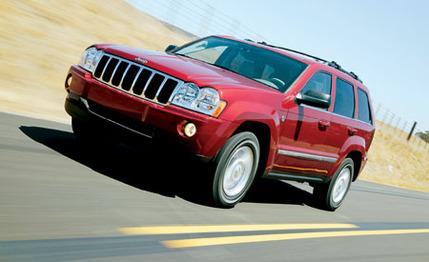 Road Test
Road Test
It's been a long time coming, but look at what Jeep has finally produced: a brand-new Grand Cherokee line with a choice of three engines (including a 5.7-liter V-8 Hemi), three four-wheel-drive systems in addition to good ol' two-wheel drive, and prices from the high 20s to the mid-40s. There should be something for everyone in that mix.
At first sight, the Grand Cherokee looks like a slightly massaged version of the previous bestseller, but closer examination reveals some substantial shifts in philosophy. The new shape is boxier, for sure, with flatter planes at the sides and rear aspect, and with less tumblehome in the greenhouse.
The wheelbase is more than three inches longer, as is the length. At 73.3 inches, the Grand Cherokee is an inch wider, providing an extra inch of hiproom that makes up the only significant increase in passenger space over the former model. It is also lower by almost two inches, with a low hoodline that greatly improves forward visibility when creeping along in the rough. Not that many owners do, of course, but our Grand Cherokee Limited 4WD wore a proud "Trail Rated" badge to reassure the faithful that four-wheel-drive versions will still slog through conditions that would stop a tank.
In front, a seven-slot grille and round headlights (designer Mark Allan insists these will appear on all Jeeps from now on) distinguish the new Grand Cherokee from its predecessors. New eyebrows over the lights are a marked departure from the rectilinear face of the old car, providing a contrast to the flat planes elsewhere on the body. The side cladding of the previous model is nowhere to be seen, and there's a chin spoiler now, helping the vehicle to better aerodynamic performance in this age of more costly fuel.
The Jeep's so-called trapezoidal wheel arches are there to maintain design continuity, and they combine with the new design so well that this latest model assumes the old car's visual persona almost immediately. In keeping with the times, the greenhouse has been shortened relative to the vehicle's height, but the use of single-pane windows in the rear doors and a bright strip below the side glass clean up the car's side view.
Other modern touches include body-color fascias front and rear, with clear taillight lenses and a chrome bumper strip. Allan says a disproportionate amount of work was done to quiet and smooth airflow around the exterior mirrors, and since these objects never brought attention to themselves throughout our test, the effort undoubtedly succeeded.
To meet impending 50-mph federal offset collision requirements, a rear tubular cradle supports and reinforces the vehicle's structure around the cargo compartment, and it doubles as a bumper bar as well as a tow-hitch mount. Inside the new Grand Cherokee you find lighter colors, plusher materials, and a new symmetrical dashboard design that can adapt to left- or right-hand-drive configurations with minimal cost.
A major mechanical departure for the Grand Cherokee comes in the form of an independent front axle, with upper and lower control arms at both sides along with an eight-percent improvement in travel compared with the solid axle of yore. Also new is a rack-and-pinion steering mechanism that replaces the old recirculating ball. The rear axle is still solid but is now located by five links, the fifth one a lateral unit acting to prevent sideways deflection.
All this nifty new hardware was present in our Grand Cherokee Limited 5.7L test car, where it combined to provide excellent tracking and turning stability, despite a ride so pillowy it bordered on outright float. Somehow, the plush ride doesn't seem to hurt the Jeep's handling. But in cars fitted with the optional dynamic handling system (DHS), which uses hydraulically engaged anti-roll bars to control body sway in corners, it ought to be even better. With DHS, the bars are disengaged on the straights and add no bump stiffness to the ride. The bars are fairly hefty to arrest roll in curves, and the overall spring rates are soft in the interests of ride comfort.
Even without DHS, our Limited wafted along pitted roadways with little noise or noticeable impact transmission. The only obvious imperfection was a bobbing motion in the dash and steering column that accompanied front-suspension excursions across rippled surfaces. Perhaps that was due to the elevated unsprung weight in the Jeep's beefy suspension bits.
If the supple ride had us expecting wallowing handling in the mountains, then the Grand Cherokee took us completely by surprise. Our 5.7L carved through the canyons with commendable poise and control, the anti-roll bars catching the Jeep's substantial mass in the corners while the rack-and-pinion steering held the car on an unvarying line.